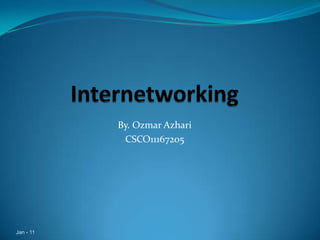
Presentasi cisco
- 3. OSI REFERENCE MODEL Created by ISO year of 1977 Framework for creating and implementing networking standards, devices, and internetworking schemes To assist data transfer between disparate hosts (different vendors) Divided into Upper and Lower Layer
- 5. TRANSPORT LAYER Segments and reassembles data into data stream to provide end to end data transport services and establish a logical connection between source and destination Well known protocol in this layer is TCP and UDP Two types of transport layer is connection oriented and connection less PDU: Segment
- 6. CONNECTION ORIENTED Provide reliable connection between hosts Use 3-way handshake to establish session There are flow control, windowing, and acknowledge to better provide the connection TCP is the sample of connection oriented protocol
- 7. NETWORK LAYER Network layer provide device addressing, tracking of device location in the network, determines best path to move data. IP Address is the well-known network layer logical addressing Two types of packets at network layer: Data packet (IP, IPX, Novell, AppleTalk) usually called Routed Protocol Route update packet (RIP, EIGRP, OSPF, ISIS, BGP) usually called Routing Protocol PDU: Packet
- 8. DATA LINK LAYER Provide physical transmission of the data and handles error detection and flow control. This layer will ensure messages are delivered to the proper device on LAN using hardware address Two pars of Data Link are: LLC MAC PDU: Frame
- 9. PHYSICAL LAYER Specify electrical, mechanical, procedural, and functional requirements for activating, maintaining, and deactivating a physical link between end systems. PDU: Byte/Bits
- 10. TCP/IP DOD STACK DoD model is the condensed version of the OSI Model, composed of four layers: Process/Application Layer Host-to-Host Layer Internet Layer Network Access layer Worldwide internet is built based on this DoD Stack
- 11. DATA ENCAPSULATION Data to be delivered through network will be encapsulated as the data goes down the layer: 1. User information is converted to data for transmission on the network 2. Data is converted into segments and a reliable connection is establish between source and destination hosts 3. Segments are converted to packets, and logical address is placed in the header so each packet can be routed through an internetwork 4. Packets are converted to frames for transmission on the network. Hardware address are used to uniquely identify host on local network segments 5. Frame are converted into bits, and digital encoding and clocking scheme are used.
- 13. HUB Device for connecting multiple devices (usually computer) together and making them act as a single network segment Works at OSI Layer 1 Obsolete and not recommended to be used in large network Dumb Terminal and only broadcast every packet its received
- 14. SWITCH Central part of LAN Network Intelligent device with switching capability Stored switching information in CAM Table Not able to break broadcast domain (except using VLAN) Do not forward packet to other network Work at OSI Layer 2
- 15. ROUTER Use to connect networks together and router packets from one network to another Break broadcast domain Use routing protocol to build routing table to make path selection Works in OSI Layer 3
- 16. COLLISION & BROADCAST DOMAIN Collision domain is a scenario where in only one particular device can send a packet on a network segment, if there are two devices send packets in the same time there will be a collision Broadcast domain is a domain where a broadcast packet will be send to every devices sit in the same domain
- 17. COLLISION & BROADCAST DOMAIN Hub has 1 collision domain and 1 broadcast domain Switch have many collision domain (depends on number of ports) and 1 Broadcast domain Router have many collision domain (depends on number of ports) and many broadcast domain (depends on number of ports)
- 18. INTRODUCTION TO ETHERNET Is a contention media access method that allows all host on a network to share the same bandwith of a link, usually called broadcast media. Has a collision prevention method called Carrier Sense Multiple Access with Collision Detection (CSMA/CD).
- 19. HALF AND FULL-DUPLEX ETHERNET Ethernet can have two mode of operation: Half-duplex Uses only one wire pair with a digital signal running in both directions of the wire Hub must use half-duplex so that end user is able to detect collision Bandwidth can not be use to the maximum, usually only 30-40% of the link bandwidth Full-duplex Uses two pairs of wires instead of one pair. No collisions will occur Faster data transfer rate (eg. 10Mbps link will get 20Mbps rate)
- 20. ETHERNET CABLING Types of ethernet cabling are: Straight-Through Cabling Crossover cabling Rolled over Cabling
- 21. STRAIGHT-THROUGH CABLING Use to Connect: Host to Switch or Hub Router to Switch or hub
- 22. CROSS OVER CABLING Use to Connect Switch to Switch Hub to Hub Host to Host Hub To Switch Router to host
- 23. ROLLED OVER CABLING Use to connect to router or switch for management purposes
- 24. OPTICAL ETHERNET Divided into two type: Multimode (MMF) Wavelength: 850nm Distance: up to 550m Nickname : S or SX (usually being called “short”) Singlemode (SMF) Wavelength: 1310-1550nm Distance: 10km (1310nm) up to 70km (1550nm) Code: L/LX/LH for 1310nm (usually called “long”)and Z/ZX for 1550nm (usually called “extended long”)
- 25. REVIEW QUESTIONS At which layer is routing occurs in TCP/IP stack? Which OSI layer can determine the availability of the receiving program and check whether there are enough resources for that communication? What Is CSMA/CD? Different between Half and Full Duplex?
- 26. THANK YOU Oct-10
Notas del editor
- Presentation: Present Data, Handles Processing such as encryption
- TCP: Transmission Control ProtocolUDP: User Datagram Protocol
- LLC: logical link control
- Denganmetodeini, sebuahnodejaringan yang akanmengirimdatakenodetujuanpertama-tama akanmemastikanbahwajaringansedangtidakdipakaiuntuk transfer daridanolehnodelainnya. Jikapadatahappengecekanditemukantransmisidata lain danterjaditabrakan (collision), makanodetersebutdiharuskanmengulangpermohonan (request) pengirimanpadaselangwaktuberikutnya yang dilakukansecaraacak (random). Dengandemikianmakajaringanefektifbisadigunakansecarabergantian.
- 568 B po, o , ph, b ,pb, h ,pc c
